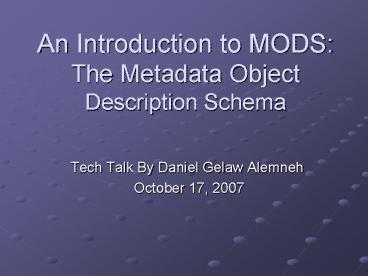An Introduction to MODS: The Metadata Object Description Schema - PowerPoint PPT Presentation
1 / 15
Title:
An Introduction to MODS: The Metadata Object Description Schema
Description:
Multiple elements are indicated for a single MODS element ... It might be difficult for MODS to make big impact today (for all communities) ... – PowerPoint PPT presentation
Number of Views:251
Avg rating:3.0/5.0
Title: An Introduction to MODS: The Metadata Object Description Schema
1
An Introduction to MODS The Metadata Object
Description Schema
- Tech Talk By Daniel Gelaw Alemneh
- October 17, 2007
2
Background Why create metadata?
- Discover resources
- Identify resources
- Locate resources
- Bring resources together
- Distinguish between/among similar and dissimilar
resources - Record rights information
- Ensure long-term access preservation
3
Approaches and Issues need to be considered
- Level of description
- Who will create metadata
- Controlled vocabularies, Authority controls
- Presentation to users
- Are you going to share it?
- Interoperability
- Rights information
4
MODS Overview
- Metadata Object Description Schema
- Descriptive Metadata Standard
- An XML schema designed to encode descriptive
metadata for digital objects - Developed at LC Network Development and MARC
Standards Office (version 3.3) - Originally designed for library use may be used
for other applications - Derived from MARC
5
MODS Development
- XML increasingly used for markup for the web
- Investigating XML for MARC element set
- Need for descriptive metadata in XML
- something simpler than MARC (with natural
language element names instead of numerical field
names) - more interoperable than qualified DC (but rich
enough for complex digital objects)
6
What is needed?
- A standard for metadata content analogous to
AACR2 - A standardized framework for holding and
exchanging metadata analogous to the MARC record
7
MODS features and Advantages
- Tags are language-based, not numeric (eg.100)
- Elements are semantically parallel to MARC
- Doesn't assume use of any particular rules
- Element descriptions can be reused
- Use of XML schema allows for flexblity
- Richer than Dublin Core
- (not too rich as UNTL Metadata, though)
- Hierarchical
- (supports rich description and works well UNTL)
8
MODS Elements
- 1. Title Info
- 2. Name
- 3. Type of resource
- 4. Genre
- 5. Origin Information
- 6. Language
- 7. Physical description
- 8. Abstract
- 9. Table of contents
- 10. Target audience
9
MODS Elements
- 10. Target audience
- 11. Note
- 12. Subject
- 13. Classification
- 14. Related item
- 15. Identifier
- 16. Location
- 17. Access conditions
- 18. Part
- 19. Extension
- 20. Record Info
10
Crosswalks
- Issues in converting existing records to MODS
- Multiple elements are indicated for a single
MODS element - Conversions without some loss of data could be
difficult - MARC to MODS
- MODS to MARC
- Dublin Core (simple) to MODS
- UNTL to MODS
11
(No Transcript)
12
(No Transcript)
13
But will MODS catch on?
- Backed by Library of Congress
- Interest from Libraries community
- 25 implementers
- There are more established competitors out there,
- Dublin Core, UNTL Metadata, etc.
- It might be difficult for MODS to make big
impact today (for all communities). However, MODS
offers exciting possibilities for the digital
library!
14
Useful addresses
- MODS
- http//www.loc.gov/standards/mods/
- METS
- http//www.loc.gov/standards/mets/
- UNTL to MODS
- http//www.library.unt.edu/digitalprojects/assets/
files/metadata/mapping/UNTL-MODS.pdf
15
.
- Thank you!































